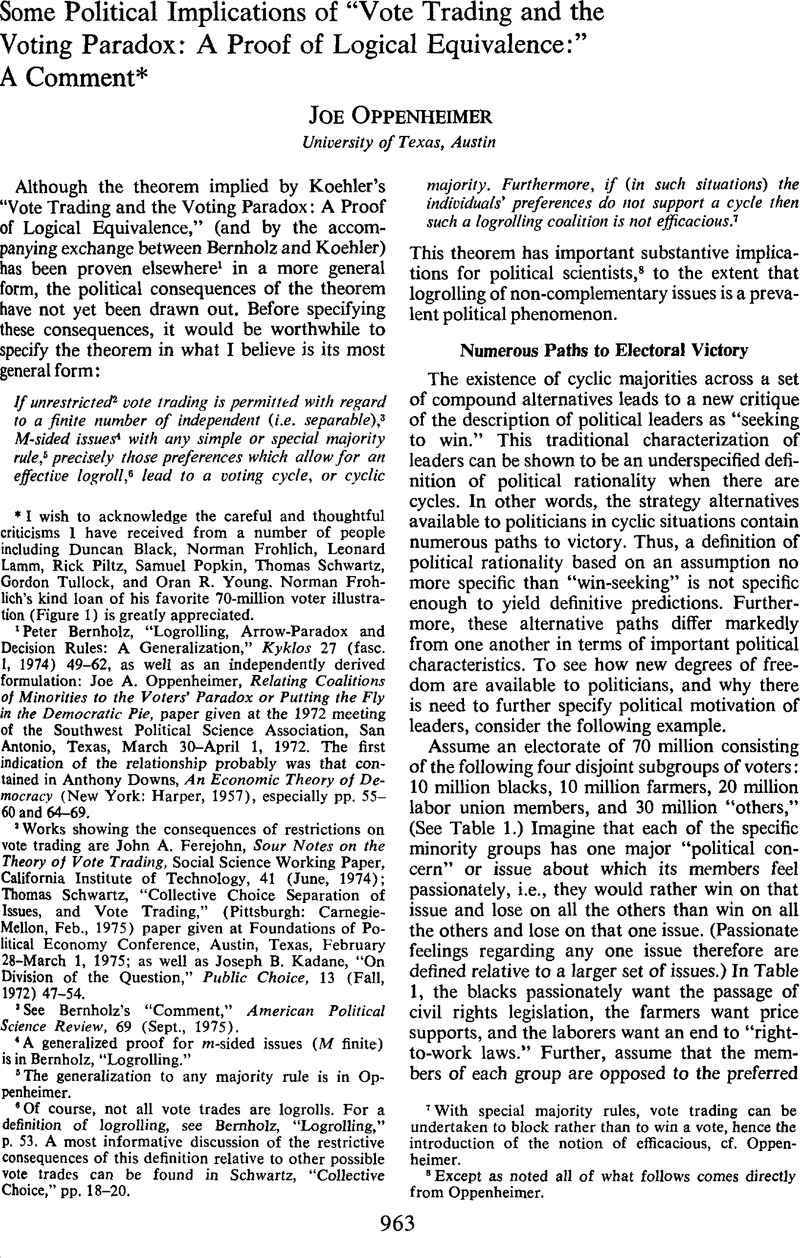Article contents
Some Political Implications of “Vote Trading and the Voting Paradox: A Proof of Logical Equivalence:” A Comment*
Published online by Cambridge University Press: 01 August 2014
Abstract

- Type
- Vote Trading and the Voting Paradox: A Proof of Logical Equivalence
- Information
- Copyright
- Copyright © American Political Science Association 1975
Footnotes
I wish to acknowledge the careful and thoughtful criticisms I have received from a number of people including Duncan Black, Norman Frohlich, Leonard Lamm, Rick Piltz, Samuel Popkin, Thomas Schwartz, Gordon Tullock, and Oran R. Young. Norman Frohlich's kind loan of his favorite 70-million voter illustration (Figure 1) is greatly appreciated.
References
1 Bernholz, Peter, “Logrolling, Arrow-Paradox and Decision Rules: A Generalization,” Kyklos 27 (fasc. 1, 1974) 49–62 CrossRefGoogle Scholar, as well as an independently derived formulation: Oppenheimer, Joe A., Relating Coalitions of Minorities to the Voters' Paradox or Putting the Fly in the Democratic Pie, paper given at the 1972 meeting of the Southwest Political Science Association, San Antonio, Texas, 03 30–04 1, 1972 Google Scholar. The first indication of the relationship probably was that contained in Downs, Anthony, An Economic Theory of Democracy (New York: Harper, 1957), especially pp. 55–60 and 64–69 Google Scholar.
2 Works showing the consequences of restrictions on vote trading are Ferejohn, John A., Sour Notes on the Theory of Vote Trading, Social Science Working Paper, California Institute of Technology, 41 (06, 1974)Google Scholar; Schwartz, Thomas, “Collective Choice Separation of Issues, and Vote Trading,” (Pittsburgh: Camegie-Mellon, Feb., 1975)Google Scholar paper given at Foundations of Political Economy Conference, Austin, Texas, February 28–March 1, 1975; as well as Kadane, Joseph B., “On Division of the Question,” Public Choice, 13 (Fall, 1972) 47–54 CrossRefGoogle Scholar.
3 See Bernholz's, “Comment,” American Political Science Review, 69 (Sept., 1975)Google Scholar.
4 A generalized proof for m-sided issues (M finite) is in Bernholz, “Logrolling.”
5 The generalization to any majority rule is in Oppenheimer.
6 Of course, not all vote trades are logrolls. For a definition of logrolling, see Bernholz, , “Logrolling,” p. 53 Google Scholar. A most informative discussion of the restrictive consequences of this definition relative to other possible vote trades can be found in Schwartz, , “Collective Choice,” pp. 18–20 Google Scholar.
7 With special majority rules, vote trading can be undertaken to block rather than to win a vote, hence the introduction of the notion of efficacious, cf. Oppenheimer.
8 Except as noted all of what follows comes directly from Oppenheimer.
9 Sen, Amartya K., “A Possibility Theorem on Minority Decisions,” Econometrica, 34 (1966), p. 492 CrossRefGoogle Scholar.
10 Perhaps it should be noted that “vote-maximizing,” in contrast to “victory-seeking” politicians would tend to choose strategies which would lengthen the cycles.
11 Of course, changes in the issues over time could also occur, as could the traditional explanation of changes in the preference orders of the members of the electorate.
12 Kadane proves MAJ is the only winner without cycles.
13 The distinction between explicit and implicit log-rolling was first made by Tullock, Gordon, “Some Problems of Majority Voting',” Journal of Political Economy, 67 (12, 1959) 571–579 CrossRefGoogle Scholar.
14 The usage parallels that of Downs in Economic Theory.
15 An exception is Bachrach's and Baratz's concern with the “issues which are never raised,” cf. Bachrach, Peter and Baratz, Morton, “The Two Faces of Power,” American Political Science Review, 56 (12, 1962), 947–953 CrossRefGoogle Scholar.
16 Campbell, Angus, Converse, Philip E., Miller, Warren E., and Stokes, Donald E., The American Voter (New York: Wiley, 1964), pp. 57, 58, and 59 Google Scholar.
17 Blydenberg, John C., “The Closed Rule and the Paradox of Voting,” The Journal of Politics, 33 (02, 1971), 57–71 CrossRefGoogle Scholar.
18 For an example of such a model, see Plott, Charles R. and Levine, Michael E., On Using the Agenda to Influence Group Decisions: Theory, Experiments and an Application, Social Science Working Paper, California Institute of Technology, 66 (11, 1974)Google Scholar.
- 19
- Cited by





Comments
No Comments have been published for this article.